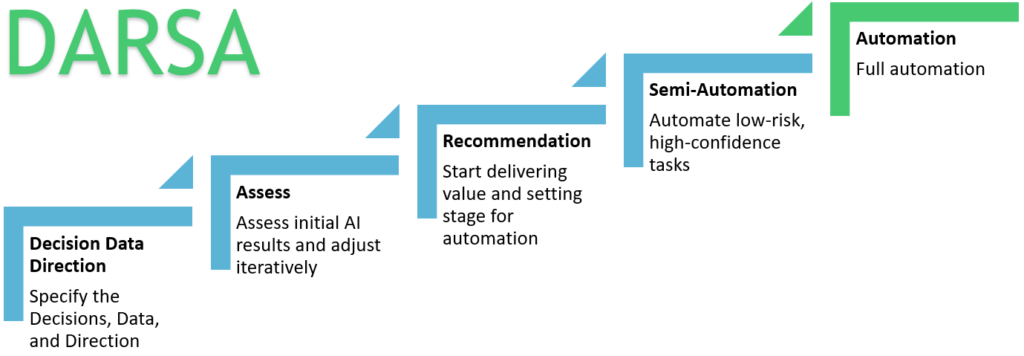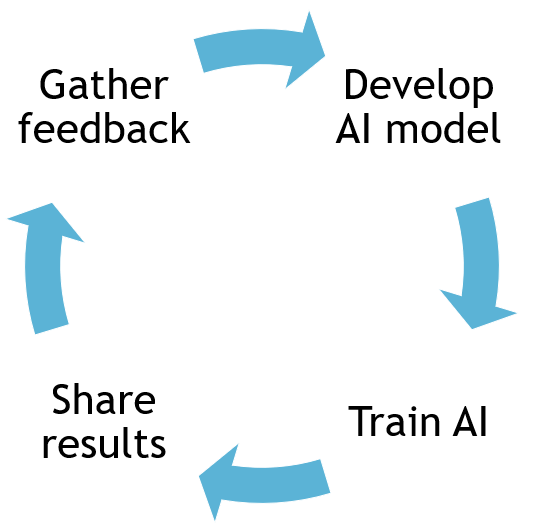In the near future, the Nuclear Corrective Action Program (CAP) will be sleek, streamlined, and highly efficient; where occasionally humans participants are required to review and deliberate over only the most complicated issues requiring their vast experience and wisdom. For everything else, a trained army of CAP AI agents invisibly process issues, review and alert on trends, assign corrective actions, and take feedback from human coaches via purpose-designed human/AI interfaces.
No longer will a team of humans be subject to hours upon days of analysis for trend detection, a Senior Reactor Operator forced to process another condition report about a cracked sidewalk, or an Engineer left waiting for a corrective action item to be issued to her inbox. These functions will have been largely automated with the focused application of AI-based technology. Here are the five reasons this future is highly probable, based on both the current state of the Nuclear Industry and leading-edge AI technology.
Cost Savings and Improved Quality
It comes as no surprise to anyone that has worked in the Nuclear Industry that running an effective CAP program is expensive. CAP demands a significant investment into human resources that have adequate experience to effectively diagnose and resolve the problems experienced in an operating power plant. In practice, this requires either dedicated staffing or rotating employees out of primary roles to fulfill a CAP function.
By applying intelligent automation to the Screening, Work Generation, and Issue Trending processes, a resource reduction of approximately 45% is expected.

Beyond reducing the number of resources required, AI reduces the total amount of time required to execute portions of the CAP process. While a human screening team may only be able to process conditions on a daily basis, an AI system can review and screen conditions and issue work items immediately. More quickly getting workable tasks into the hands of employees saves money and improves CAP quality.
For those issues that may be too complex for AI to effectively handle, a human-in-the-loop system can be employed, where AI knows when it is unsure and can reach out for human assistance. By using human-in-the-loop the cost of the CAP program is reduced while keeping quality the same or better.
Additionally, AI can lower the threshold for issue documentation. Deployment of an information extraction AI lets employees more naturally capture issues using natural language, without filling out specialized forms. When issues become easier to document, they are documented more often, the overall information input into the CAP program increases, and the chance an issue is corrected becomes greater. AI that immediately evaluates the quality and completeness of the submitted report enables automated dialogue with the submitter. This can encourage behaviors such as adding information, clarify issues, correcting spelling, or otherwise encourage behaviors that promote report quality, increasing the effectiveness of the overall CAP program.
Scale
The most valuable problems to solve are frequently the largest. CAP and associated activities are one of the largest opportunities in Nuclear. CAP lies at the heart of the Nuclear Industry, and requires participation from almost every trade and profession at each site. The ubiquity of CAP combined with the savings potential provides an immense incentive for plant operators, industry vendors, and industry research groups to discover and implement ways to make these programs run more sustainably and efficiently. Specialized AI that can automate various tasks are at the top of mind of industry groups such as the Electric Power Research Institute, the Idaho National Laboratories, and various utility in-house teams.
A fortunate side effect of the CAP program is the production of large quantities of high-quality data – data ideal for training the AI systems that will be used to automate the same functions. Most of this data is captured in free-form text as natural language. Language with a specific Nuclear vocabulary and dialect, but natural language nonetheless. The scale of this data puts it on par with the datasets utilized by the large technology vendors and academic institutions to develop and train the most effective AI systems. Thanks to the scale of Nuclear CAP data, these large AI systems can be specialized to operate in the Nuclear domain – increasing performance and effectiveness for the tasks at hand.
Transportability
The most notable advancements in AI technology of the late 2010s were around the development of advanced natural language-based AI. This AI has the ability to understand human language more naturally and effectively than previously thought possible. Breakthroughs in this area are characterized by the ability of AI to transfer learning from one problem to another. An AI good at classifying condition report quality will be better at identifying equipment tags vs one specifically trained just to identify equipment tags.
The benefit for the nuclear industry is that an AI system trained at Plant X will be able to transfer its learning to Plant Y and be more performant than one trained at just Plant Y. This is similar to how a working professional at Diablo Canyon would more easily adapt and apply their knowledge when transferring to Turkey Point than someone not having worked in the nuclear industry at all. Similar to a human employee, an AI system will benefit from the variety of different knowledge obtained from general industry data. Learning specifics for any one plant will be faster, cheaper, and easier for any plant wishing to specialize the AI system for use in automation once trained on general industry data.
As a result, solutions developed at one site will be able to be shared. With commonly applicable training and similar problems, the industry can work to solve the big problems once with ‘large’ or ‘hard’ AI, and transport the solution from plant to plant for the benefit of the entire industry.
Automated Screening
One of the more specific solutions apparent when applying AI to the CAP process is the automation of the condition screening process. Condition screening is the process of reviewing a received report of a non-standard condition in or around the plant, then applying certain tags, codes, or classifications, assigning an owner, and generating the appropriate work items that address the condition. For some plants, this process involves dedicated groups of senior employees that work daily to manually perform this process. For others, this involves dispersed resources periodically gathering together to complete screening. In either case, the resources are usually senior-level and experienced, and thus expensive. The following estimation of resources spent by the industry for this process each year illustrates just how large an opportunity there is:

The screening process has certain properties: repeatability and complexity of task, quality of data, scale, cost, etc. that make it extremely promising to apply AI-powered automation — discussion worthy of a separate blog post…coming soon!
Automated Trending
Automated trending is the sequel to Automated Screening – it’s what comes after the conditions have been identified and actions issued. Normally done ‘cognitively’ or via brute force search of the condition data, trending is resource-intensive and largely manual. Read Nuclearn’s Nuclear CAP Coding AI – Better Performance at a Lower Cost to find out more about how AI can help automate and simplify the trending task.
Bonus: The Rapid Progress of AI Technology
The five points above are only achievable due to the explosion in the progress of various technologies that underpin how AI learns and behaves. The speed in recent years with which new AI tools achieve human-level performance on various vision and language tasks is unprecedented. As seen in the chart below, developing AI that can recognize simple numerical digits at human-level performance took over 10 years; to recognize cats, dogs, cars and other everyday objects in images took about 5 years. More recently, developing AI that can recognize and manipulate human language took only about 2 years.

The accelerating pace of AI advancements shows no sign of stopping anytime soon. This type of rapid advancement, combined with the scale, transportability, and savings of CAP, allows Nuclearn to confidently say AI is the future of Nuclear CAP.





